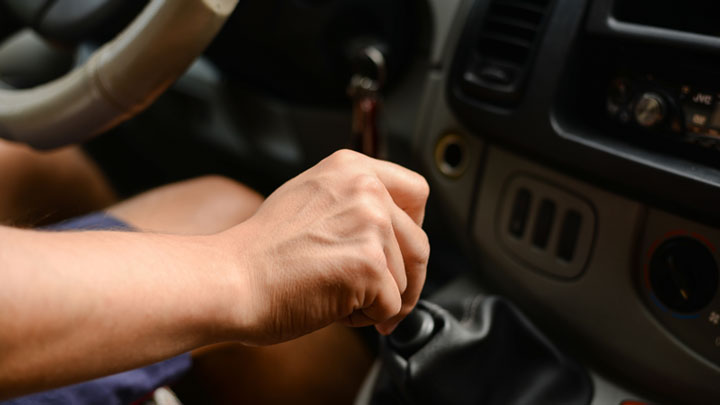8 Symptoms of a Bad Clutch Slave Cylinder (and Replacement Cost)
If you’ve been driving your manual transmission vehicle for a while, you know how everything should feel when you push down the clutch to change gears. So, when something feels off, you’ll want to take notice.
One component that can fail that you might not be too familiar with is the clutch slave cylinder. But what exactly is a clutch slave cylinder, how does it work, and what are some common symptoms that can help you diagnose when one goes bad?

- Symptoms include: Soft/hard clutch pedal, leaking fluid, difficulty shifting gears, contaminated clutch fluid, squeaky sound, grinding gears, and sinking clutch pedal.
- Most common cause: contaminated hydraulic fluid, which causes seals to fail and leads to leaks.
- Replacement cost: $200-$250 for outside the transmission to $900-$1700 for inside.
What Does a Clutch Slave Cylinder Do?
Before you can diagnose a faulty clutch slave cylinder, you need to know what it does in the first place and to get a better understanding of that you need a basic understanding of how the clutch works.
When you depress your vehicle’s clutch pedal, you’re manually pushing a rod into the clutch master cylinder. The clutch master cylinder converts this force into hydraulic pressure, and that hydraulic pressure releases the clutch plate so your vehicle can switch gears.
Once you release the clutch pedal, the clutch slave cylinder gets to work. The clutch slave cylinder simply reengages the clutch pedal and your vehicle jumps into the new gear.
The clutch slave cylinder is always trying to engage the clutch, that way whenever you release the clutch pedal, your vehicle gets back into gear.
Where Is It Located?

The clutch slave cylinder is the last component in the clutch hydraulic system. There are a few possible locations for it, and it could be either inside or outside the transmission. In a semi-hydraulic system, the slave cylinder is on the outside of the bell housing, releasing the clutch plate via a release fork.
Typically, these systems mount the clutch slave cylinder with two bolts, making it pretty easy to find, remove, and replace. However, in some systems, the clutch slave cylinder is inside the transmission.
These systems require a bit more work to get to the clutch slave cylinder, as you’ll usually need to remove the transmission to access the slave cylinder.
Slave Cylinder vs Master Cylinder

While both the clutch slave cylinder and the clutch master cylinder are necessary to operate the clutch, they are two completely different components that work hand-in-hand with each other to help your vehicle shift gears.
The master cylinder converts the mechanical pressure into hydraulic pressure to release the clutch plate, while the slave cylinder provides the pressure to push the pressure plate back into place when there’s no hydraulic pressure.
If either component starts to fail, you won’t be able to shift your vehicle properly, but they actively work against each other to make it happen!
See Also: Brake Master Cylinder Replacement Cost
Bad Slave Cylinder Symptoms
While a slave cylinder isn’t a component you should need to replace all that often, if it’s starting to fail, it will create some noticeable problems. If you notice any of the following symptoms, the problem could definitely a faulty slave cylinder. The more symptoms you notice, the more likely that’s the case.
#1 – Soft Clutch Pedal

A soft clutch pedal is one of the most common signs of a faulty clutch slave cylinder. This makes sense because if the cylinder starts to fail it won’t push back as hard to reengage the transmission, and you’ll feel that in the clutch.
It’s also possible that you could feel a spongy or intermittent pressure on the clutch pedal either when pressing or releasing the pedal.
See Also: What Does “Riding the Clutch” Mean?
#2 – Leaking/Low Fluid Level in Clutch Slave Cylinder
The clutch slave cylinder uses oil to keep everything well lubricated and moving the way it should, and if the seals give out this fluid can leak out all over the place. If that happens it won’t continue to work the way it should and you’ll need to replace it.
You might actively spot the leak, or you might notice that it’s low on oil. Since it’s a sealed system, if it’s low on oil, there’s a leak somewhere and you need to replace it.
#3 – Difficulty Shifting Gears

The clutch slave cylinder works in tandem with the master cylinder to help your vehicle shift gears, so it makes sense that if either component starts to fail that you’ll start to have problems when trying to shift gears.
Often with a faulty clutch slave cylinder, you’ll notice a problem when your vehicle is trying to get into the next gear.
#4 – Contaminated Clutch Fluid
If your vehicle has dark or contaminated clutch fluid, there’s a problem with one of the seals somewhere in the system.
The problem could be the seals around the clutch slave cylinder, or the problem could be with the seals around the clutch master cylinder.
#5 – Squeaky Sound When Pressing the Clutch

When you depress the clutch, everything should engage silently. If you’re starting to hear grinding noises or a squeaking sound, it could mean a problem with the clutch slave cylinder.
The slave cylinder can begin to make these noises if there’s a leak and it runs low on oil or if components can no longer move the way they should without a little extra force.
#6 – Grinding Gears When Shifting
When the clutch slave cylinder is working the way it should, it provides enough pressure for the transmission to quickly get into gear after you release the clutch pedal. The speed is important, otherwise gears can start to grind and create more problems.
If you’re starting to hear grinding gears when you’re trying to shift, you’ll want to get to the bottom of it right away because grinding gears can lead to more damage.
#7 – Clutch Pedal Sinks to the Floor

If the clutch slave cylinder isn’t working the way it should, it won’t reengage the clutch plate. When this happens, nothing is pushing the clutch pedal back up into place, so you’ll often start to see it sinking to the floor.
It depends on how quickly the clutch pedal will sink to the floor. Sometimes it will fall all at once, while other times it will slowly fall to the floor.
See Also: How to Adjust a Clutch Pedal
#8 – Hard Clutch Pedal
While it’s more common to feel a soft clutch pedal than a hard one, it all depends on how the clutch slave cylinder fails.
For instance, if the cylinder fails and stays stuck in the position where it’s pushing too hard to keep the clutch plate depressed, you might struggle to disengage it. While this isn’t the most likely way for the cylinder to fail, it can happen.
What Causes the Slave Cylinder to Fail?
Clutch slave cylinders don’t fail all that often, so if the one on your vehicle does fail, you’ll want to figure out why. The most common reason a clutch slave cylinder fails is because of contamination of the hydraulic fluid. Contaminated hydraulic fluid will cause the seals to fail, and when that happens the clutch slave cylinder will leak.
Other potential causes of a clutch slave cylinder failure include foreign contaminants entering the system and causing components to rust or fail in other ways. This can happen if the clutch master cylinder has a faulty seal or if a hose allows contaminants into the system in other ways.
If the fluid stays clean and contaminants don’t enter the system, the clutch slave cylinder usually won’t fail, even if it’s on an older vehicle!
Clutch Slave Cylinder Replacement Cost
Best places to order parts? See: 19 Best Online Auto Parts Stores

The cost to replace your vehicle’s clutch slave cylinder depends on whether the cylinder is inside or outside the transmission. Most of the time they’re on the outside of the transmission, and these are far less expensive to replace.
That’s because there’s usually only about an hour of labor with this job, compared to 8 to 16 hours of labor that goes into removing and reinstalling the bell housing.
But since most of the time, they’re on the outside of the bell housing you can usually expect to spend between $200 and $250 for a professional mechanic to install a new clutch slave cylinder. Of this cost, about $100 to $115 is for the part, and the rest is for the labor.
If your vehicle’s clutch slave cylinder is inside the transmission, you’ll need to multiply the shop’s hourly rate by 8 or 16, then add $100 to $115 for the part.
Auto repair rates can vary quite a bit, typically in the range of $75-$150 per hour. So if you take a shop that charges $100/hour, you’d be looking at somewhere between $900 to $1,700 to replace a clutch slave cylinder that’s located inside the transmission.
Now you know how important it is to make sure the hydraulic fluid in your clutch system is in good condition.
Can the Slave Cylinder Fail Without Leaking?
Yes! While one of the most common ways a clutch slave cylinder fails is through an external leak, these parts can absolutely fail because of internal problems.
If a spring fails or starts to rust too much if the piston gets stuck, or if there’s another internal failure the clutch slave cylinder can fail even without an external leak.
- P0521 Code (Symptoms, Causes, How to Fix) - Mar 22, 2024
- How to PROPERLY Clean 5 Types of Steering Wheel Materials - Feb 19, 2024
- What Should You Do If Your Check Engine Light Comes On? - Nov 6, 2023

Good evening
I’m driving a Toyota conquest 1.3, it a 4speed gearbox so it has locked the gears on gear 3, it has been slipping on gear number 4.
So what could be the problem?
I don’t know. Sounds like it could be a problem inside the transmission.